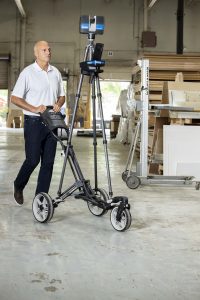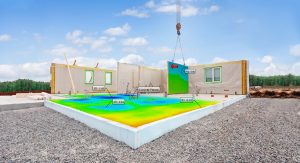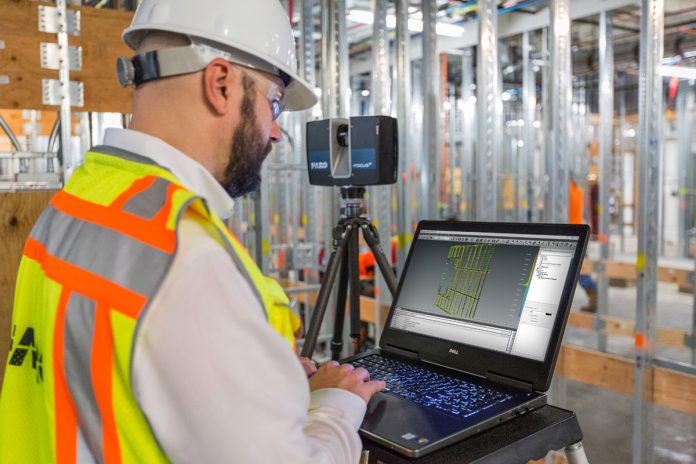Mobile 3D laser scanning is emerging as a valuable tool to gather building information in greater detail while saving time and money – and improving worker safety
Technological innovation is often broken down into what could be described as leaps and half-leaps.
Leaps are the giant steps forward. The integrated circuit, or microchip, is a good example. Capable of holding billions of individual transistors, it more than any other 20th-century technology, paved the way for the impressive computer power we take for granted today. The increasing megapixels of a smartphone camera or a software upgrade are, by contrast, a half-leap – an incremental point of progress.
 Leaps and half-leaps are important partners. If all we had were leaps, change would come too fast and unplanned obsolescence (versus planned obsolescence) would dominate. On the other hand, if all we had were half-leaps, said change would come too slowly and we’d still be bragging about our transistor radios.
Leaps and half-leaps are important partners. If all we had were leaps, change would come too fast and unplanned obsolescence (versus planned obsolescence) would dominate. On the other hand, if all we had were half-leaps, said change would come too slowly and we’d still be bragging about our transistor radios.
Only the right balance of revolution and evolution makes sense. Thus, for the 3D laser scanning industry – forecast to be worth $4bn by 2025 – and AEC professionals who increasingly rely on these cutting-edge technologies, the next evolutionary step is the widespread embrace of in-field mobile scanning versus more traditional static methods.
Like with any incremental point of progress, the transition from static to mobile 3D laser scanning has taken time. It’s also taken plenty of research and development that’s given rise to a herculean increase in on-the-go computer processing and cloud-based data sharing.
Powered by sophisticated software that can directly import into any CAD system with 3D point cloud capabilities and that can optimise scan to BIM workflows, mobile scanners are ideal for large construction companies, general contractors, and facility and plant managers, who require the most accurate as-built models and building documentation while ensuring unmatched construction quality control.
Monetisation potential
Today’s advanced mobile scanners come in two varieties: handheld devices and scanners mounted to wheeled tripods, small vehicles or carried as part of a backpack apparatus, where the operator walks at a comfortable pace and quickly scans an interior space. While mobile 3D scanning is mostly confined to industrial-grade uses, Apple’s LiDAR Scanner for the iPad Pro 2020 (compatible with the Measure app) is an example of the technology’s broadening reach, as well as its lowering price point.
Regardless of which route companies choose, 3D mobile scanning offers similar immediate benefits:
- The ability to capture colour images while the scan is taking place, thanks to mounted cameras. This means the colourised 3D point cloud is ready for instant applications, saving time and money.
- On-scene flexibility means exploring tight spaces and hard-to-reach spots that a static scan would struggle to capture. Time and money are saved here too as no setup or scanner repositioning is required.
- Mobility allows operators to avoid other on-site distractions like people and extraneous material. With mobile scanning, there is no need to wait for after hours to return to a scene to capture previously inaccessible data.
- Compared to their bulkier cousins, handheld scanners are easier to use and feature a faster learning curve. Getting your team up to speed in record time (with fewer support staff) means there’s more time to get the job done.
- Enhanced capability to more quickly communicate site walk-throughs with clients – and to do so in a socially distanced manner with fewer people on site.
These benefits come at an important time as AEC professionals look to improve their end-to-end efficiencies and reverse two (possibly three) disturbing trends illuminated by a noteworthy McKinsey analysis. In the consulting firm’s Imagining Construction’s Digital Future report, it found that large construction projects typically take 20% longer to finish than scheduled and cost 80% more than budgeted. It also found that if anything, construction productivity has declined in some markets since the 1990s at a time when static 3D laser scanning was just gaining widespread use.
At a moment where the health and safety of on-site personnel are paramount concerns, getting the job done as fast and as accurately as possible is essential. It’s also a matter of simple economics and ROI: if a static scan used to take hours to complete can now be done 10X faster, new business can be accepted faster than ever before.
The hybrid solution
That’s true whether the new business exists in North America, 3D laser scanning’s largest market, in Europe, with estimated market size of $2bn by 2022, or in Asia-Pacific, the region with the fastest growth.

But as with any emerging technology, there’s often a cost-benefit analysis. For industries using 3D scanners, there’s a battle between ultimate speed versus ultimate quality. Today’s mobile scanners are fast, yes, but they still can’t capture as many data points per second as their static scanning counterparts.
One solution to this challenge is for businesses to invest in a hybrid approach: a mobile scanner capable of switching between mobile and static modes. As a best of both worlds option, users can speedily scan a large indoor space, like a factory or an aircraft hangar, before a possible upgrade or total repurposing. And it can also capture the finer details of, say, assembly line equipment with the ability to scan up to 2m points per second via stationary operation.
The result is that as-built capture jobs that would normally require one hour or more to complete with a static scan, could be accomplished in as little as six minutes. That’s an impressive 90% decrease. By toggling between static and mobile use cases, businesses can maximise their efficiency while improving ROI.
Scanning by leaps and bounds
So whether you’re the owner of an office building looking to expand and require an as-built 3D digital image of the space as it exists, or if you’re restoring a historic building to its original design blueprints, or planning to rebuild your hospital, mobile 3D digital scanning is increasingly the speedy and economic choice for a variety of industrial applications.
For businesses looking for an added edge, mobile scanning (and their mobile-static hybrid alternatives) might be the ideal investment.
Half-leap innovations might not always be front-page news. But in the words of American essayist, playwright, novelist and civil rights leader James Baldwin: “If you can alter, even by a millimetre, the way people look at reality then you can change the world.”
For the AEC industry in Europe and elsewhere, 3D mobile scanning is the literal realisation of Baldwin’s inspiring words.
Matthias Koksch
Director of AEC Solutions
FARO
Please note: this is a commercial profile.

















